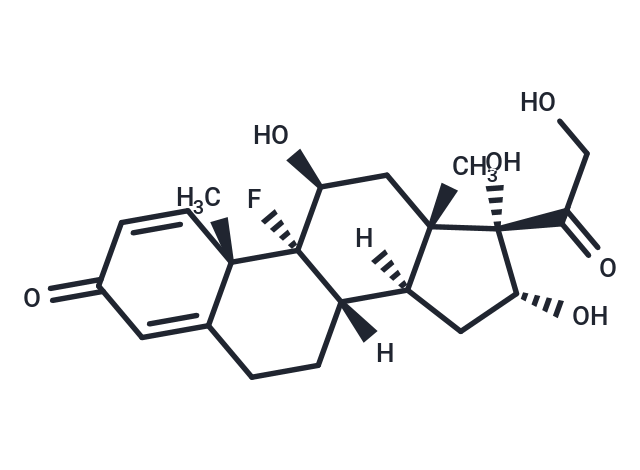- Remove All
 Your shopping cart is currently empty
Your shopping cart is currently empty
Triamcinolone
Triamcinolone (Aristocort) is a synthetic glucocorticoid with anti-inflammatory and immunomodulating properties. Upon cell entry, triamcinolone binds to and activates the glucocorticoid receptor, which leads to translocation of the ligand-receptor complex to the nucleus and induces expression of glucocorticoid-responsive genes such as lipocortins. Lipocortins inhibit phospholipase A2, thereby blocking the release of arachidonic acid from membrane phospholipids and preventing the synthesis of prostaglandins and leukotrienes, both mediators of inflammation. In addition, pro-inflammatory cytokine production, including interleukin (IL)-1and IL-6, and the activation of cytotoxic T-lymphocytes is also inhibited. T-cells are prevented from making IL-2 and proliferating. This agent also decreases the number of circulating lymphocytes, induces cell differentiation, and stimulates apoptosis through increasing Ikappa-B expression and curtailing activation of nuclear factor (NF)kappa-B.

Triamcinolone
| Pack Size | Price | Availability | Quantity |
|---|---|---|---|
| 500 mg | $45 | In Stock | |
| 1 mL x 10 mM (in DMSO) | $50 | In Stock |
Product Introduction
| Description | Triamcinolone (Aristocort) is a synthetic glucocorticoid with anti-inflammatory and immunomodulating properties. Upon cell entry, triamcinolone binds to and activates the glucocorticoid receptor, which leads to translocation of the ligand-receptor complex to the nucleus and induces expression of glucocorticoid-responsive genes such as lipocortins. Lipocortins inhibit phospholipase A2, thereby blocking the release of arachidonic acid from membrane phospholipids and preventing the synthesis of prostaglandins and leukotrienes, both mediators of inflammation. In addition, pro-inflammatory cytokine production, including interleukin (IL)-1and IL-6, and the activation of cytotoxic T-lymphocytes is also inhibited. T-cells are prevented from making IL-2 and proliferating. This agent also decreases the number of circulating lymphocytes, induces cell differentiation, and stimulates apoptosis through increasing Ikappa-B expression and curtailing activation of nuclear factor (NF)kappa-B. |
| Alias | Rodinolone, Fluoxyprednisolone, Aristocort |
| Molecular Weight | 394.43 |
| Formula | C21H27FO6 |
| Cas No. | 124-94-7 |
| Smiles | [H][C@@]12C[C@@H](O)[C@](O)(C(=O)CO)[C@@]1(C)C[C@H](O)[C@@]1(F)[C@@]2([H])CCC2=CC(=O)C=C[C@]12C |
| Relative Density. | 1.42g/cm3 |
| Storage | Powder: -20°C for 3 years | In solvent: -80°C for 1 year | Shipping with blue ice. | ||||||||||||||||||||||||||||||||||||||||
| Solubility Information | Ethanol: 1 mg/mL (2.54 mM), Sonication is recommended. DMSO: 55 mg/mL (139.44 mM), Sonication is recommended. H2O: < 1 mg/mL (insoluble or slightly soluble) | ||||||||||||||||||||||||||||||||||||||||
Solution Preparation Table | |||||||||||||||||||||||||||||||||||||||||
Ethanol/DMSO
DMSO
| |||||||||||||||||||||||||||||||||||||||||
Calculator
In Vivo Formulation Calculator (Clear solution)
Dose Conversion
Tech Support

Copyright © 2015-2025 TargetMol Chemicals Inc. All Rights Reserved.



